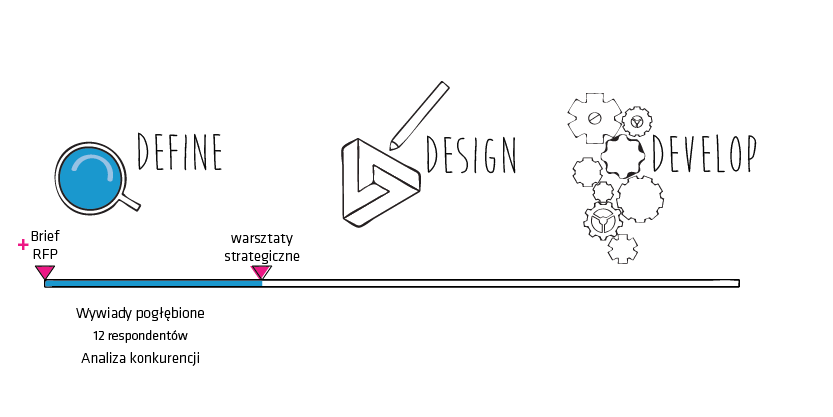6 waysóLego went beyond the accepted standard
In late 2014, one of our key customersów approached us with a proposal to create a new version of his TV, this time on the Internet. The aim of the new service was to go into the future and create a solution for 2020. In this wayób we have started work on nc+ GO.
Put the user at the center of your thinking
In order to meet the challenge set by the client, we proposed to work in a user-centered model and to place the user at the center of all our considerations. The second assumption was a very close cooperation with the clientóooperation between the design teamóon the part of Insys and nc+, wspónc+ GO users who are constantly fine-tuning the final form of the nc+ GO service.
Define the requirements
The first stage was to investigate the trend ofóThe results of our meeting were the customer paths in the video market with the help of a broad benchmark of solutions available on the market.
In order to better understand the needs of the useróIn addition, we conducted a dedicated qualitative study, whichóevidence was supposed to explain to us how our potential customers behave. During the research with 12 people we had a chance to find out what róreactive behaviouróThe marketer’s newsletter (to learn about new products in the series) is one of the most important factorsóThe aim of the new service was to go into the future and create a solution for 2020.
One of the essential róThe difference we observed was a greater attachment to the channelóon TV in osób, whichóre using pay-TV.
Based on the diagnosed needs, we conducted co-creation workshops with nc+ representatives, whichóWe worked out the value proposition of the service and preliminary functional assumptions. Our meeting resulted in customer pathsóIn order to meet the client’s challenge, we proposed working in a user-centric model and putting it at the center of all our considerations.
Explore mockups with users
The work on defining functionality was carried out in a wayób iterative, and each iteration was dedicated to one of the devices. The work was always followed by a stage of testing the mock-ups with users.
By using 5 iterations of the testóIn this case, the child has to build with blocks in order to gain additional poweróand the problemów, któthat would be expensive to remove at the manufacturing or finished product stage.
While working on the project we learned that the content presented on the mockups in a direct wayób translate into a reflection ofór of the project by the respondents – If they were not realistic enough, they prevented respondents from properly assessing the functionality.
In the course of our work we also used mockups based on HTML and CSS. However, it turned out that such refined mockups are more difficult to change and therefore less useful in the process of iterative improvements. Therefore, in future projects we will use tools dedicated to prototyping e.g. Axure.

WspóWork with your development teams
The most difficult and also the longest phase of our project was the development work. In retrospect, we’ve learned that there is a pyramid.in that… It’s not enough to design – you also have to properly describe what there is to do. Here in a wayób clear understanding of what róThe difference between action on the part of the UX agency, where the key is the concept and communication of the idea, and action on the part of the contractor, where the idea is to be implemented. Now we devote much more time to analytical work and description of requirements and more strictly supportedówe work together as a team.
The less time between design and development, the better – topics obvious at the design and analysis stage become less clear. Better results come from smaller portions of work to complete – the larger the areas of Now develop at once, the greater the problems in releasing subsequent versions. Now we work more efficiently, based on smaller releases, reducing the time between specifying a requirement and its implementation as much as possible.

Watch the finished product
Over time, by analyzing user behavior and commentsóWe can see that there is a pyramid of user needs. If the basic ones are not satisfied, then the higher-order ones w ogóle are not taken into account. This means that investing in features that exceed user expectationsów is worth implementing only if the basic ones are properly implemented.
Based on data from Google Analytics, we can see that users are focusing on areas of the site thatóthat deliver value to them in the simplest, most effective wayób. One of such places is the Now on TV screen, on whichóIn addition, they can freely explore what’s on other channels while watching. Our observations show that users stay on the site because they don’t need to move on to watch TV. Additionally, they are free to explore what is on other channels while watching. After all, we don’t turn off the television to flip through a TV show.
Take a holistic approach to your project
The ecosystem of the service consists of many components. To master the complexity of such a phenomenon, it is useful to start with the user, understanding their needs and behaviors. Technology serves these needs, and thanks to it, in ogóbut it is possible.
Users always treat the service as a whole, inseparably connected with content and form. That’s why it’s a good idea to approach a project holistically, without getting locked into a confrontation between the contractor and the client. Thanks to the successful cooperation withóhe cooperation between nc+ and Insys exceeds 200 thousand. registered userów enjoys access to television on the internet.
